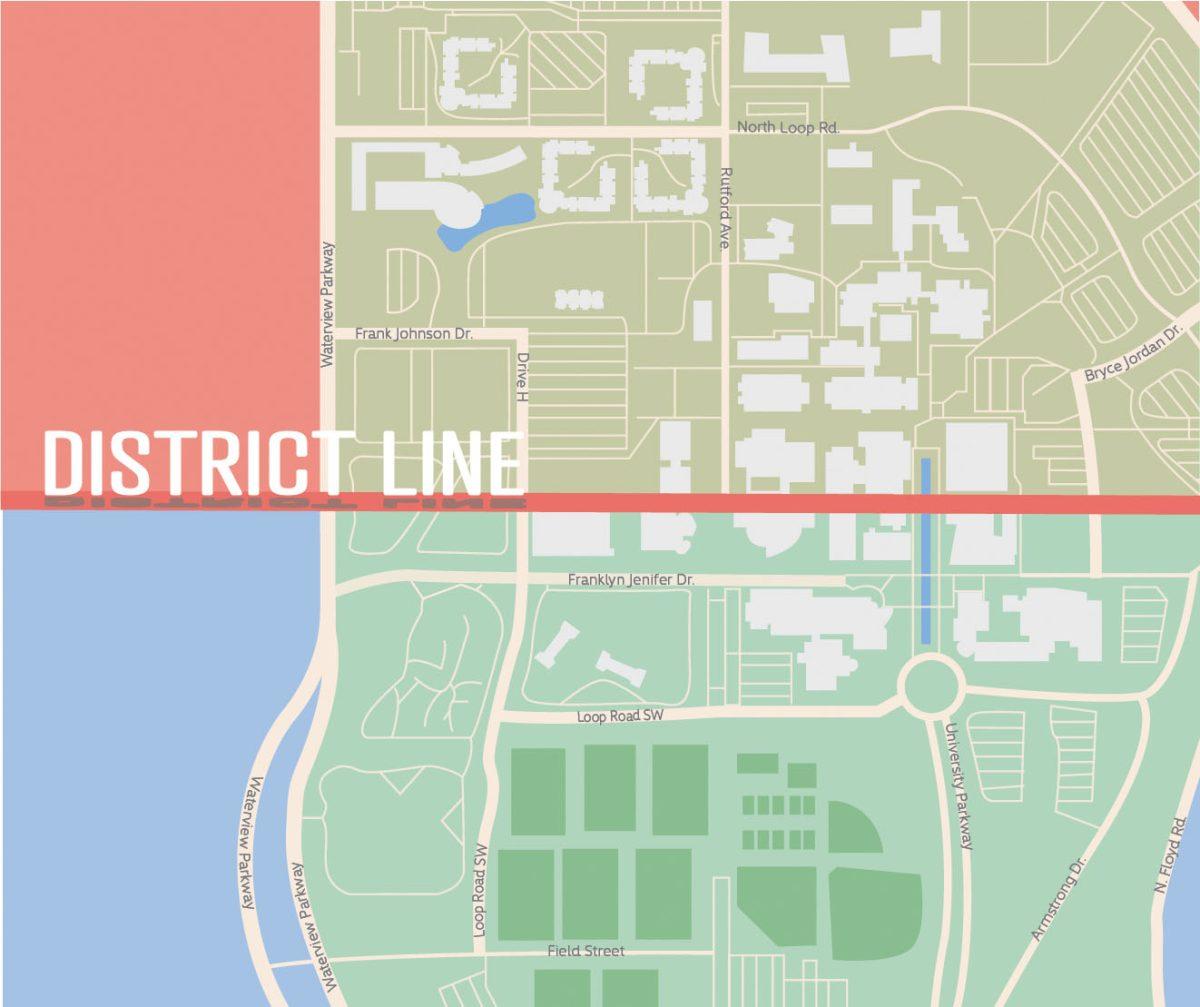Near Franklyn Jenifer Drive, a congressional district line splits the UTD campus in half. This distinction determines which congressional candidate, county judge and even state congressman students vote for, depending on which on-campus housing options they choose.
The county line runs east horizontally from Waterview Parkway to Rutford Avenue. Canyon Creek and University Village Phases 1–3 fall in Dallas County’s Precinct 2500. University Commons residence halls, Northside and University Village Phases 6–9, in contrast, vote in Collin County’s Precinct 55. Even more divided are Phases 4 and 5, which rest on the county line. There, residents’ registration depends not only on which building but in which apartment they reside.
President of UTD College Democrats and political science junior Fawaz Anwar said the split affects student access to polling sites.
“In the 2016 election, the closest Collin county voting site was a few miles off campus,” Anwar said. “That’s not that far if you have a car, but if you’re an out-of-town student without a car, you have to rely on the generosity of others to drive you. Or you can Lyft yourself, which I’d argue is a de facto poll tax at that point.”
Student Government Legislative Committee Chair Ben Darling, an accounting and finance senior, said he thinks the biggest effect of the split is voter apathy.
“We see really poor political engagement, although it’s improving, among our age,” Darling said. “A lot of college students aren’t super engaged or don’t know politically what’s going on.”
Political science lecturer Patrick Larue said the division especially matters in light of the close congressional race in Dallas County. Larue said Texas’s 3rd congressional district — which includes the north half of campus — is projected by polling aggregate service FiveThirtyEight to be won by Republican Van Taylor. In contrast, the southern part of campus falls in Texas’s 32nd congressional district, where he said recent poll data indicates a toss-up race within 2 percentage points.
Larue said the campus divide forces students to better understand the electoral process, voter registration and local government, but may lead to confusion about which elections they may vote in.
“I can easily imagine a situation where students may see posters, stickers or signs for Colin Allred, research him and show up to vote for him, only to discover once they reach their polling location that Colin Allred isn’t even on their ballot because they live within the District 3 boundary instead of the District 32 boundary,” Larue said.
The northern portion of campus falls into Precinct 55, where 1,591 constituents voted for Hilary Clinton over Donald Trump 49 percent to 41 percent in the 2016 presidential election. South of Franklyn Jenifer Drive, 1,469 voters chose Clinton over Trump 50 percent to 44 percent in Precinct 2500.
Darling said the county line leads to difficulties in voter registration for UTD students because some neighboring on-campus living spaces do not belong to the same county. If a freshman were to move from Residence Hall South to Canyon Creek Heights the next year, they would have to change their voter registration.
“(The divide) is super inconvenient, especially for registering voters on campus,” Darling said. “It’s one of those things where we need as few roadblocks as possible between people and political engagement.”
U.S. congressional district lines, including the one near Franklyn Jenifer Drive, are partially based on the Dallas and Collin County boundary. The first building at UTD was the Founder’s Building in Collin County, but fifty years later, the campus has grown significantly to extend into the two separate counties. To solve the issue, Anwar said UTD should consider being completely annexed by either Collin or Dallas County.
“I think it would make a lot more sense administrative-wise for the entire campus to be in one county,” Anwar said. “If you look at some of these congressional districts, they’re all gerrymandered already. Would it really be that big a deal to annex UTD to one side or the other? Then again, we don’t know how this university votes because it’s been so difficult to find voter data — because it’s split in half.”
Darling said a Democratic student in Collin County may be less likely to vote because that particular county is historically Republican.
“Regardless of my partisan leaning, do I want to vote in (Collin County) in a noncompetitive election?” Darling said. “The biggest consequence is Collin County kids feeling like, what’s the point of getting registered or involved when I’m trying to fight against this huge infrastructure and I’m just one person?”
Darling said it is crucial for students to feel relevant in the democratic process, as a student who doubts their role is less likely to participate in their civil right to vote.
“I want people to feel like they have a place in (the political process). Sometimes it feels like there’s a barrier in the way, and I want people to feel like they can come engage with politics and get educated,” Darling said. “Our generation can be one that has big impact.”











